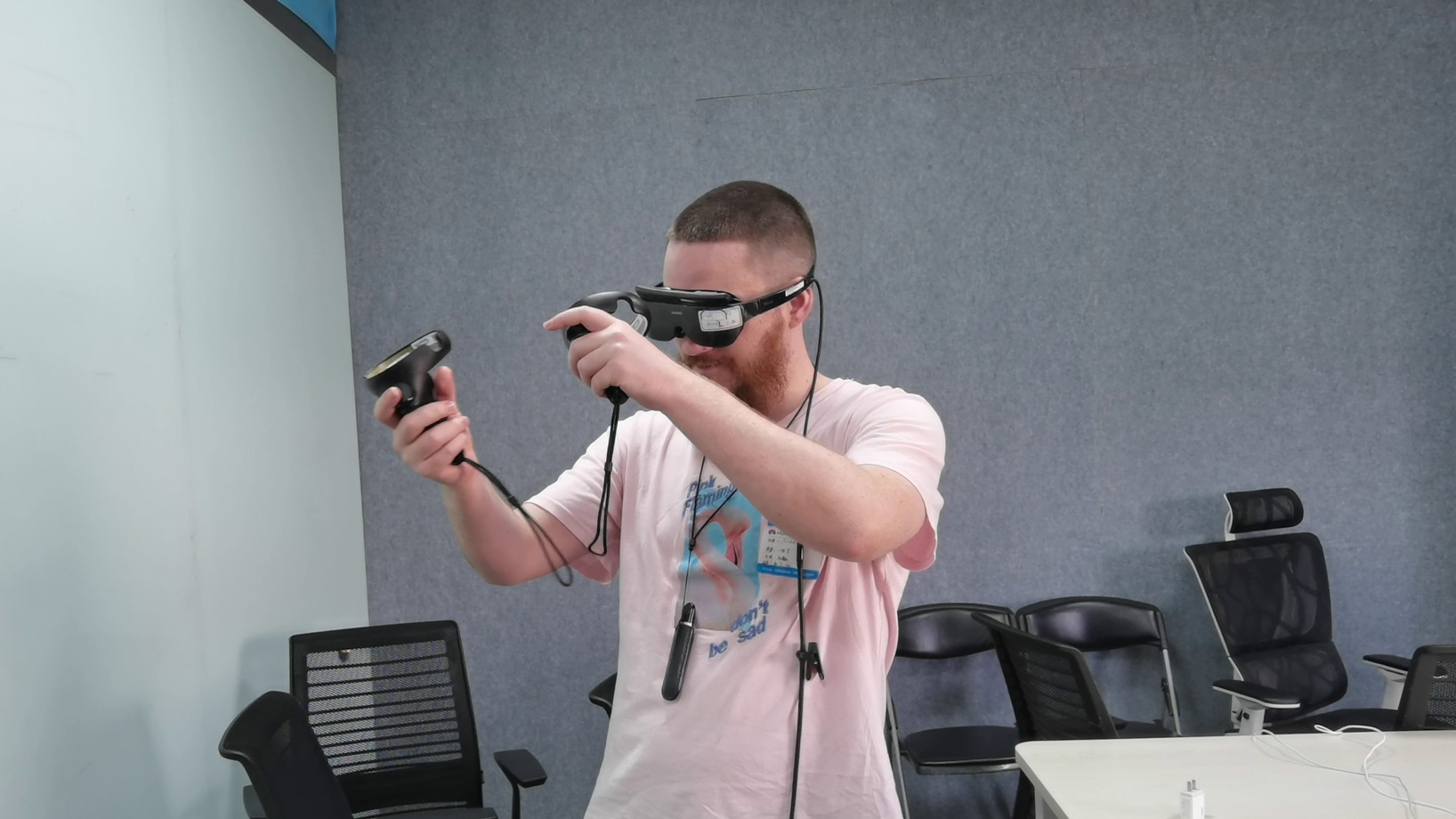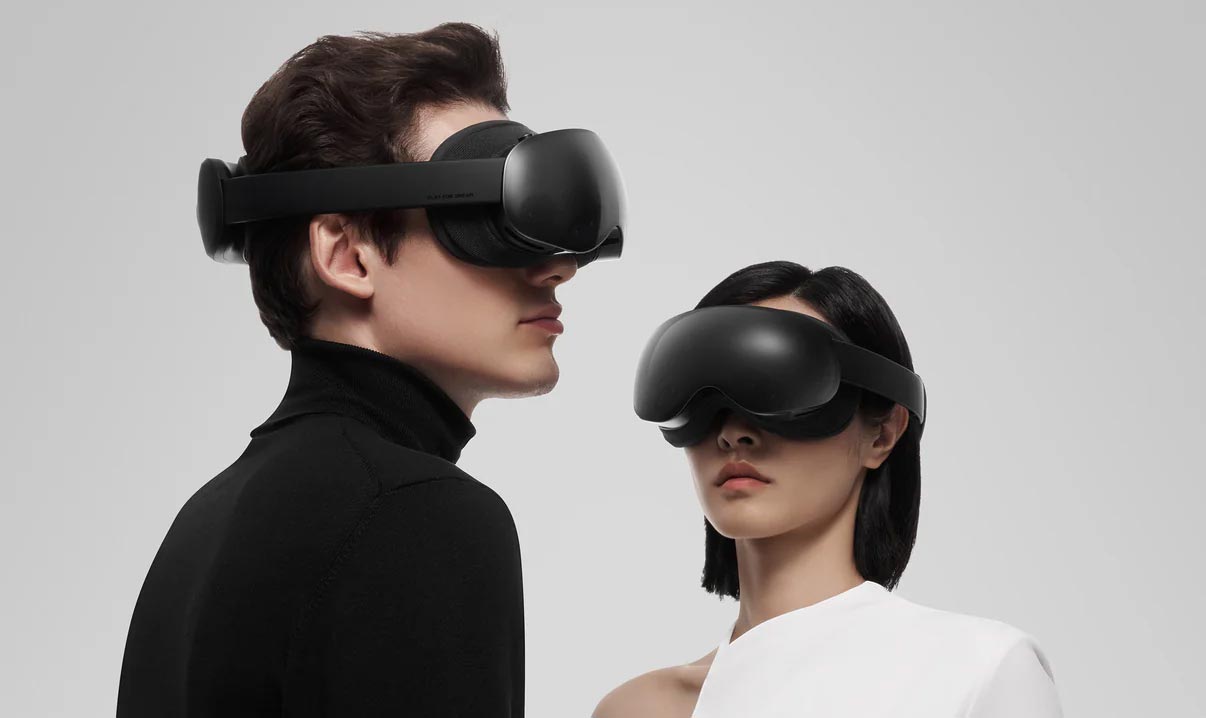Exclusive hands-on with Huawei VR glasses 6DOF devkit (with FXG’s Nikk Mitchell)
Today I’m very excited to present to you an exclusive preview of the 6DOF devkit for the Huawei VR glasses. An amazing pre-review that has been possible only thanks to the collaboration with Nikk Mitchell, the fantastic CEO of FXG, a Chinese VR company that has a partnership with Huawei. Fasten your seatbelts and let’s go!
Huawei VR glasses 6DOF devkit – Video Preview
Nikk and I have created a video to showcase you everything about this Huawei 6DOF devkit:
- What is it;
- How does it work;
- How you can install it;
- What are its performances inside multiple applications;
- How you can use it with PCs and mobile phones;
The video is very informative but also funny and contains a surprise contest in the end (participate in it!). I strongly advise you to watch it here below. It is pretty long, so we added some timestamps to help you in watching only the parts you care about.
As always, I have also prepared a textual description of what you can find in the video… keep reading in case you prefer texts over images.
Huawei VR glasses
Some years ago, Huawei announced its new lightweight VR glasses: an HMD that looks like a pair of bulky sunglasses, with a form factor completely different from the one of the other VR headsets. It can be so lightweight and compact thanks to two design decisions:
- The headset is not a standalone, but it is an all-in-two: to work it must be connected to your phone or your PC. Since it features no computational unit and no battery, it can be smaller and lighter than “shoebox” headsets like the Oculus Quest that must contain everything inside;
- Thanks to the use of pancake optics, the screen can be closer to the lenses, for a very compact design. This comes at the expense of the FOV, which for this reason is smaller than the one of the other headsets.

I have tried it in Nanchang in 2019 and I came out pretty impressed from it (you can read my full review here). I was especially pleased by the design: the headset is so lightweight that is very comfortable to use, and especially it has a form factor that I wouldn’t be ashamed to wear on a public bus, because it looks like bulky sunglasses. The display had a very high pixel density: thanks to the limited FOV and the high resolution of the display, the angular density was very high and so the screen door effect was almost inexistent. Yes, the 90° FOV felt a bit limited, but it wasn’t a big nuisance to me.
The headset had a big problem though: it was just a 3DOF one. In Nanchang, Huawei was making people try it together with a Nolo tracking kit, but this was a sub-optimal solution. We all know the precision issues of Nolo, and then an all-in-two headset has little sense if tracking only works in the location where there is a a tracking station. So, it was good only as a media viewer. But now, things are going to change…
Specifications

These are the specifications of the Huawei VR glasses:
- Display: FAST LCD, 1600 x 1600 pixels per eye
- FOV: 90°
- Pixel density: 1058 PPI
- Refresh rate: 70Hz on mobile, 90Hz on PC
- Weight: 166g
- Audio: integrated speakers and microphone
- Optical adjustment: 0-700° diopter adjustment (IPD supported: 55-71mm)
- Connectivity: USB-C, Bluetooth
- Compatibility: PC (SteamVR), Huawei phones
6 DOF devkit for Huawei VR glasses
Since the biggest problem of this headset was that it was 3DOF, Huawei has worked hard to create a 6DOF version of it. We all know that VR without interaction feels very limited, and that 3DOF is so much 2018, so it is amazing that Huawei has taken this decision. This 6DOF device is still at the devkit stage at this moment, and Huawei is looking for the help of developers to develop it at its best.
The devkit is already available to selected developers in China, and there are already some companies that are creating content for it. One of these selected companies is FXG, a VR content production startup in Hangzhou, a beautiful city in southern China. Its CEO is the amazing Nikk Mitchell, a very active and passionate VR guy: he’s a friend of mine, and he’s also one of my Patrons, and so it came natural for us to collaborate for this article, to inform all of you of the community about what Huawei is doing in VR.

Nikk has tried the devkit for us and gave us his first impressions on it, which I’m going to detail here below. Notice that while reading this review you must remind that this is just a devkit: its performances are of course not perfect, and its design and features may change before the final release. You have been warned!
6DOF Devkit components
Huawei people have been very smart because instead of releasing a completely different headset, they have just released an add-on that you can plug on the top of your already existing 3DOF VR headset to transform it into a full 6DOF device. This remind me of the initial choice that HTC took when it released the 6DOF tracking add-on for the Vive Focus: in the end, it was never released and the company just launched the new Vive Focus Plus.

The kit is composed by:
- An inside-out tracking add-on, that you attach to your glasses so that that they can track themselves (positional tracking) and the controllers;
- Two controllers that are very similar to the Oculus Touch. The buttons and the triggers are the ones that are now the de-facto standard for VR controllers.

What I really love about the controllers is that they can be fit together so that they form a unique element, and this new element can be used as a stand for the glasses. So with the Huawei glasses, you don’t need a stand, it is the controllers that are already a perfect stand for all the set. A genius idea that makes you understand how the design of all the parts has been carefully studied.
Setup
The setup of the 6DOF add-on is incredibly easy. You just have to remove a little cap on the top of the 3DOF glasses to uncover a little USB port, inside which you stick the little bar with two cameras for the 6DOF tracking. You then wear the controllers, and you are ready to play!
The glasses can be connected to a PC, where you can use them to play SteamVR games. Notice that Nikk shows in the video that you must install Huawei VR runtime to be able to use the glasses this way.
With its latest runtime, it is also possible to plug the glasses into one of the latest Huawei phones to use them as a 6DOF device in full mobility. The connection between the phone and the glasses happens via a USB-C cable.
Hands-on performances
I guess at this point you may be thinking “ok, it’s all cool, but… does it work?”. You are asking the right questions, and we are here to answer you. According to Nikk, the performances of the devkit are good:
- The positional tracking of the headset works very well. You can move your head fast in all directions, and it keeps tracking you. He also reports a very smooth and low-latency tracking;
- The tracking of the controllers is good but it could be better. It works fairly well in standard conditions, but it could have some problems for fast movements. Then there is the issue of the FOV: since the tracking cameras are only two front ones, the tracking FOV of the controllers is a bit less than 180°, meaning that the system can’t track them when your hands go beyond your head, like in a bow-and-arrow game.
In the video posted above, you can see that Nikk does the first tests playing in his office, and then he goes to Huawei headquarters in Shenzhen to try the latest firmware of the headset. The latest firmware brings dramatic improvements to the tracking of the controllers, which are now more reactive to fast movements. This shows how Huawei is investing resources to improve the performance of the devkit, and this is a piece of very good news for when the 6DOF kit will be officially released. Of course, the problem with the tracking FOV can’t be solved with this version of the device, because it is given by the position of the two tracking cameras.

From the hands-on session, I have also understood another thing: Nikk sucks at Beat Saber. I will use the videos he sent me where he loses some matches at Normal difficulty after 30 seconds to blackmail him and make him send to me a Huawei 6DOF headset.
Price and release date
Huawei has released no public information about price, release date, and even final form factor of these 6DOF glasses. The 3DOF VR glasses are on sale in China and cost around 3000RMB (around 470$).
The importance of Huawei
I think we should all keep an eye on what Huawei is doing in the XR space. We all wonder who can be the Facebook competitor, and we often talk about Microsoft, Apple, Samsung, but we usually forgot about Huawei. Before the US ban, Huawei was one of the major manufacturers of smartphones, and it is probably at the moment still the company with the biggest expertise on 5G. It is a technology giant… just to give you a single significant metric about how big it is: Facebook, which we consider having infinite money, had in 2020 a total revenue of $86B; Huawei in the same period totaled $136.7 billion. Yes, it’s like 50% more than Facebook… this is the power of the Chinese market. They already have great expertise in hardware, so I wouldn’t be surprised if they could be able to deliver an interesting XR headset if they wanted to invest seriously in immersive technologies.
An opportunity for all you developers

Huawei is working on creating this all-in-two 6DOF VR headset. Of course, they are aiming at jumpstarting their ecosystem, so they are looking for developers interested in porting their titles to the Huawei Store, and potentially access the big Chinese market. They are offering various kinds of support for this, including funding part of the development efforts: if you may be interested in this, contact directly FXG to evaluate a possible collaboration with Huawei. I’ll personally evaluate this with our team at New Technology Walkers for our HitMotion: Reloaded game.
That’s a wrap! It’s been very interesting and very fun to evaluate the Huawei VR Glasses 6DOF devkit together with my friend Nikk. I hope you have enjoyed it as well, and if it is the case, don’t forget to subscribe to my newsletter not to miss my next post… and also don’t forget to follow Nikk and FXG on Twitter at @nikkmitchell and @FXG_VR!
And for whatever question, doubt, comment… let us know here in the comments or on our social media channels. Nikk and I will be very happy to answer you!
(Header image by FXG)
Disclaimer: this blog contains advertisement and affiliate links to sustain itself. If you click on an affiliate link, I'll be very happy because I'll earn a small commission on your purchase. You can find my boring full disclosure here.



